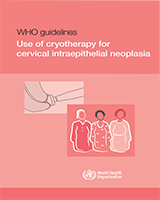This document summarizes the recent WHO recommendations for the use of cryotherapy in women with histologically confirmed CIN. The methods recommended by WHO for guideline development were followed, and a series of systematic reviews were conducted to inform these recommendations. The panel, comprising experts from around the world, developed 14 recommendations, while considering the international audience and application of these guidelines in low-, middle- and high-income countries.
These guidelines are directly applicable to women with histologically confirmed CIN, but may be applicable to women who have been screened positive without histological confirmation. However, this review and the recommendations did not address the issue of “single-visit” or “screen-and-treat” approaches. We recognize that in many cervical cancer prevention and control programmes, treatment is commonly offered on the basis of a screening test result alone, such as VIA, most often because histological confirmation is not available or is programmatically feasible. Thus, although not all women who screen positive will have CIN, treatment by cryotherapy according to these present guidelines can be provided. In addition, the recommendations for cryotherapy using the double-freeze techniques and different gases (CO2 versus N2O) are directly applicable to any populations of women receiving cryotherapy who have positive screening test results without confirmatory histology diagnosis. These cryotherapy recommendations are also essential for the forthcoming development of the WHO “technical specification and procurement of cryotherapy equipment”, and for programme managers wanting to scale-up national cervical cancer and prevention programmes.
As in most guidelines, many of these recommendations are conditional, due to the absence of moderate or high quality of evidence. Therefore, clinicians and policy-makers will need to consider available resources (including costs, equipment and human resources), and the presumed values and preferences of women presenting with precancerous lesions found at the time of screening. For suspicion of glandular disease, the evidence was considered too indirect or sparse to develop recommendations, and so the panel did not formulate recommendations. There is also little evidence for cryotherapy use among HIV-positive women and those who are pregnant. For recommendations in these populations, the panel agreed that the benefits of treatment to prevent cervical cancer outweighed the unknown or uncertain harms, but that future research will need to be considered for future updates of the recommendations.
A strength of these recommendations is the process used by the expert panel. Specifically, the recommendations were made considering the totality of the available evidence and using the transparent and rigorous methods recommended for all WHO guidelines. Thus, despite the frequently indirect evidence from studies that lacked independent control groups, the panel had at hand comprehensive evidence summaries when making decisions regarding recommendations. The WHO guideline process also provided a systematic approach to decision-making, and a method to transparently record the benefits, harms, values, preferences and resource use for each recommendation decision.
The limitations of these guidelines are inherent to the lack of available evidence to answer key questions. Guidelines in general, and for WHO in particular, should provide recommendations based on the best available evidence. Much of the best available evidence for these guidelines came from pooled data across observational studies, which did not include independent control or comparison groups. Because of this, the estimates of comparative effects were frequently based on indirect comparisons, that is, comparisons were made across studies rather than within studies, leading to considerable uncertainty about the best estimates of effect. More importantly, the efficacy estimates of cryotherapy compared to no intervention are based on observational data that were not properly controlled. While trials comparing cryotherapy to no treatment to determine the effectiveness of cryotherapy are not ethically sound or feasible, studies comparing different techniques or equipment (e.g. a trial comparing women randomized to receive cryotherapy with N2O versus CO2, or different-shaped cryo tips) could, and should, be conducted. Moreover, randomized trials comparing the effects of providing additional counselling and education to standard best-practice counselling have not been performed. While most providers might assume that detailed education and counselling would be inherently effective, the cost–benefit analysis of the additional time spent, and measurement of potential harms, such as increased anxiety or treatment refusal, need to be explored.
These guidelines provide recommendations on the use of cryotherapy for cervical cancer prevention, and will be incorporated into the next update of Comprehensive cervical cancer control: a guide for essential practice. WHO has committed to updating the guide and will focus the next steps on reviewing the evidence to make recommendations for (1) health education; (2) HPV vaccines; (3) use of screening tests, including HPV testing as a primary stand-alone test; (4) treatment of precancerous lesions other than with cryotherapy; (5) “screen-and-treat” or “single-visit” approaches based on VIA of the cervix with and without HPV testing, followed by cryotherapy; and (6) additional guidance on prevention and management of positive screening tests in HIV-infected women.

